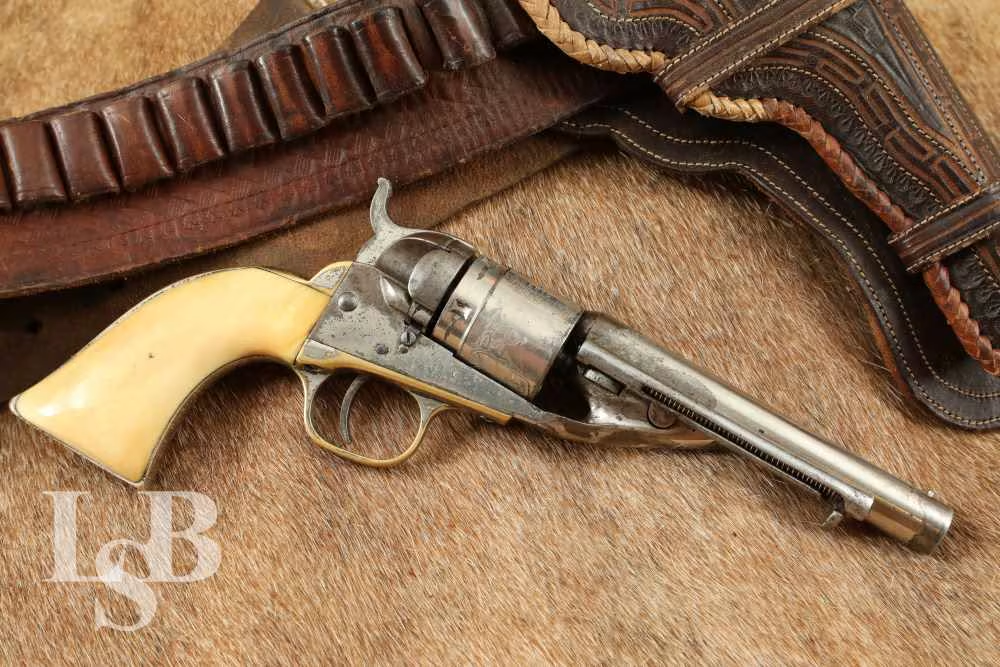
Colt 1849 Pocket .38 CF Factory Converted Nickel Revolver, 1852 Antique
SOLD FOR: $1,725.00
LSB#: WY241113SK047.1
Make: Colt
Model: 1849 Pocket .31 Factory Converted to .38 Centerfire
Serial Number: 45123
Year of Manufacture: 1852, Converted Later
Caliber: .38 ”Short” Colt Centerfire Cartridge
Action Type: Single Action Revolver with Open top cylinder.
Markings: The butt of the grip, just in front of the trigger guard, the bottom of the frame, the number on the cylinder, and the bottom of the barrel lug are all marked with the serial number. The top of the barrel is marked “COLT PT FA MFG CO/ HARTFORD CT USA”. The Cylinder Stage Coach Scene is crisp and very visible. The left of the trigger is “38 Cal.”; The “3” has faded.
Barrel Length: 4.5”
Sights / Optics: The front sight is a brass post. The rear sight is a “V” cut into the top of the hammer.
Stock Configuration & Condition: The grip is smooth Ivory on a flat-butt grip frame. There are no notable compressions and draglines and one chip and two cracks in the bottom left of the grip or cracks. The grips are in about very good overall condition.
Type of Finish: Nickel
Finish Originality: Original to Factory Conversion
Bore Condition: The bore is bright and the rifling is well-defined. There is minimal scattered erosion in the bore. The bore rates at 8/10 for an antique.
Overall Condition: This handgun retains about 75% of its metal finish. There is scattered finish loss that has oxidized. There are rub marks and patches of cloudy finish. There are some nicks and dings. There is verdigris on the trigger guard. There is flecking of the nickel throughout. The screw heads are lightly tool marked with strong, serviceable slots. The barrel-wedge screw is marred but useable. The markings are clear. Overall, this handgun rates in about very good condition.
Mechanics: The action works correctly. The cylinder lockup produces barely any side-to-side play. We did not fire this handgun. As with all used firearms, a thorough cleaning may be necessary to meet your maintenance standards.
Box, Paperwork & Accessories: Comes with a leather holster and belt rig. The holster and belt are in good condition.
Our Assessment: The expiration of Rollin White’s patent on revolvers with bored-through cylinders in 1869 was a true watershed moment for the U.S. Firearms industry. Now all firearms manufacturers would be able to directly manufacture cartridge revolvers without having to risk lawsuits or pay royalties. Colt was no exception, especially considering that Samuel Colt himself had PASSED on the chance to purchase exclusive rights to the patent in the 1850s.
Colt was however still somewhat committed to percussion revolvers, so it wasn’t until 1873 that their first purpose-made cartridge revolver, the Single Action Army, was introduced. That did not mean however that this was their only effort, as there was also a fairly large market producing parts and materials for converting percussion revolvers to take rimfire and centerfire cartridges. For designs such as the Remington “New Model” Revolver, this was relatively simple, as the cylinder could be swapped out easily with one that took cartridges. Some would use a back plate, while others would modify the hammer slightly. Colt revolvers however did not have a solid frame that allowed easy removal of the cylinder, so they required more involved conversions. There were private companies that made conversion kits to supply gunsmiths, and companies that did all work in-house as well. Colt also decided circa 1873-1874 to use leftover parts from percussion revolvers to make some early rimfire cartridge revolvers. They also may have converted revolvers left over in stock and allowed customers and retailers to send back revolvers for the conversion.
During the early conversions parts such as the grip, grip frame, and trigger guard were left alone, while the frame, trigger, and cylinder required modification. The recoil shield on the right side was machined out and a spacer was installed in front. This allowed the cylinder to be loaded from the rear, and extensions were added to the hammer to contact the cartridge rims. The rear of the cylinder was machined away, leaving the ratchet but completely removing the cap bolsters. In this case, the cylinder would also need to have the chambers enlarged for the .38 cal cartridges. We believe that the barrel was completely replaced on these conversions.
The cylinder is in very good condition and still has the original COLTS PATENT marking above the serial number, as well as much of the “Stagecoach Holdup” scene still visible. The patent markings on the left side of the frame are still present. The revolver not only looks great but it is in tight, fully functional condition, with a strong hammer pull, solid indexing, and a firm cylinder lockup. The bore shows clear lands and grooves, with a semi-bright finish, showing some wear from use as well as past powder fouling. The pistol metalwork still retains much of the Nickel plating in some areas, though others have lost most of it. We assume that this revolver saw a good amount of use after the cartridge conversion. The revolver displays a peppery patina where the plating has flaked away. The Ivory grip is in good shape and shows long use.

